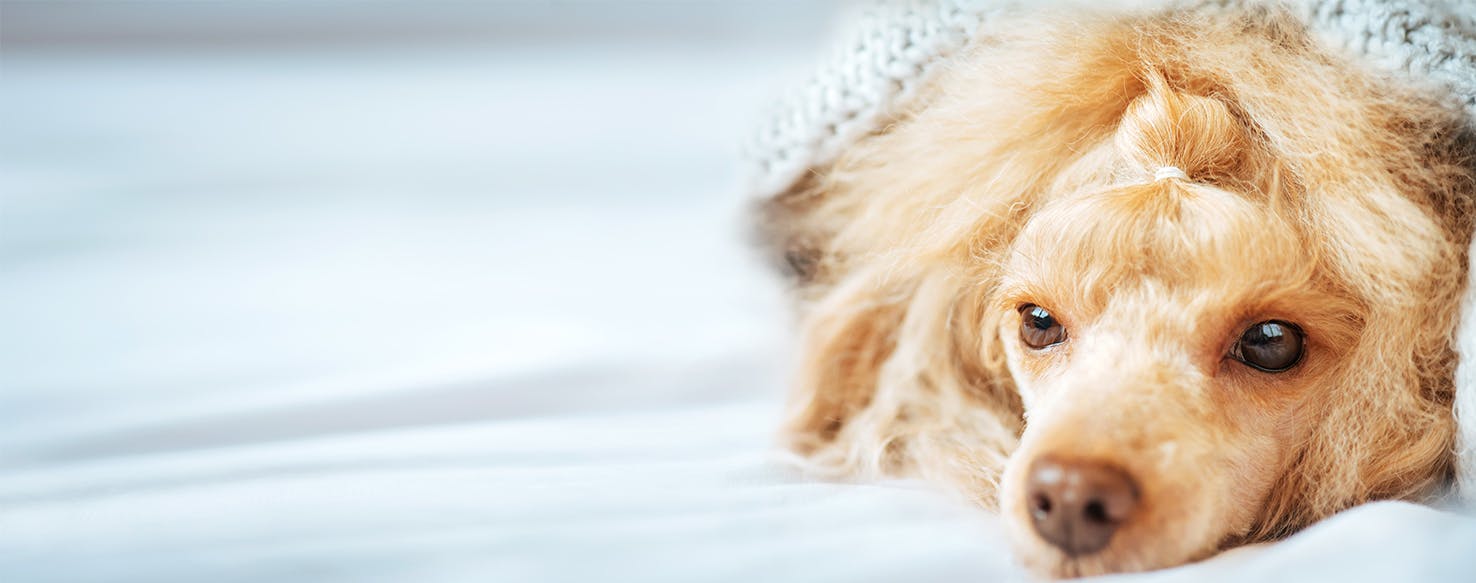- Home
- The Daily Wag!
- Behavior
- Why Does My Dog Cover My Baby with a Blanket

Unusual
Concerning
Our lovable canine companions often seem like they may know far more than we give them credit for. Many dogs begin acting differently when their owners are expecting or when they bring home a new addition to the family. They may be more attentive and snuggly than they ever have been before. Some dogs are better “nannies” than other dogs, carefully watching or guarding the new baby. The internet is rife with videos of adorable dogs taking care of their tiny human companions. What does it mean when dogs cover babies up with blankets? Are they just taking care of their new human sibling, or does it mean something else entirely?
When a dog covers up a human baby, your first thought might be something along the lines of “awwww.” But this seemingly nurturing behavior may not be as pure and loving as it first might seem. The truth is that dogs don’t cover their own babies this way. The unfortunate reality is, they do display this kind of behavior with food or toys. You may have seen your dog try to cover up their food bowl or bury a toy or a bone in the backyard. Wolves and other wild canines use this “caching” behavior commonly, to keep food safe from other predators. Wolves, foxes, and wild canines hoard because they don’t always know when they’ll get their next meal. When they have an opportunity to eat and then save more for later, they take it. This behavior in domestic dogs is similar. Typically, dogs will engage in from food-hoarding when they don’t feel secure enough in their environment, either because of other dogs they view as competition or some other environmental factor that is causing them stress.
Dogs may not understand that they’re going to be fed every day as usual and may feel that they have to ensure they’re going to get a meal later. Newly rescued dogs may be more prone to this kind of behavior while they’re still adjusting to their new home and routine. Possessiveness is also a factor in hoarding behavior. Some dogs may be more possessive than others, which may be a parentage and genetic-based behavior, rather than a breed-specific type. Possessive dogs may ignore their owner’s commands, especially to drop a beloved toy or treat or may even growl at other dogs during meal times. Minor possessiveness may drive some dogs to hoard or protect what they view as their resources, whatever that may be. Sometimes, even your belongings might become the targets of your dog’s caching and stashing.
Need advice about your pet's health?
Get answers fast from a veterinary professional 24/7 in the Wag! App.
Get Vet ChatIf your dog is prone to hoarding behaviors, whether with food, toys, or your belongings, you should make sure you create a structured, controlled routine for your dog. If they hoard toys, start by removing all but one or two toys for them to play with. They’ll be less likely to hoard since they would then be out of playtime options. With food, always make sure your dog has set mealtimes. Do not feed your dog until they can sit calmly and submissively. If your dog is overexcited or pushy, feeding them only rewards that behavior. If your dog walks away from the bowl, take the food away so they’re unable to come back and stash any for later. Having control over their food and routine establishes you as the master in your relationship, which is important for curbing unwanted behaviors like hoarding.
If your dog is persistently trying to cover your baby, you may need to separate them. Keeping your dog away from your baby is the only way to completely prevent your dog from acting possessively. Baby gates are a great way to keep your dog away from your little one. Also, reinforcing training with phrases such as “drop it” and “leave it” are important to prevent your dog from trying to hoard. And creating clear boundaries and off-limits zones, such as your baby’s nursery, is always a good idea.
Many people can’t help humanizing their beloved canine companions.
But it’s important to always remember that dogs are dogs and not people, no
matter how much we believe otherwise. Domesticated dogs may be intelligent and even
good-mannered, but they are still driven by instinct—instincts that have
existed since their wild ancestors roamed the world. If your dog displays this kind of hoarding or burying behavior,
you should pay particularly close attention to your dog around your baby at all
times. It is possible that your dog may begin to act aggressively out of fear
or anxiety, especially if your dog’s routine has changed dramatically. Your dog
won’t understand why their usual day is so different, and some dogs don’t deal
well with change. Stress and anxiety can result in fear-based aggression.
Consult a trainer for advice on dealing with possessiveness and hoarding.
While it might appear sweet, dogs covering babies might not be done for nurturing reasons. Just like their wild ancestors, dogs are driven by instincts and some of these instincts we humans still do not understand. Dogs and kids often grow to be best buddies, but when your child’s safety is a concern, it is always best to play it safe.
Written by a Border Collie lover Charlotte Perez
Veterinary reviewed by:
Published: 03/27/2018, edited: 01/30/2020
More articles by Charlotte Perez

